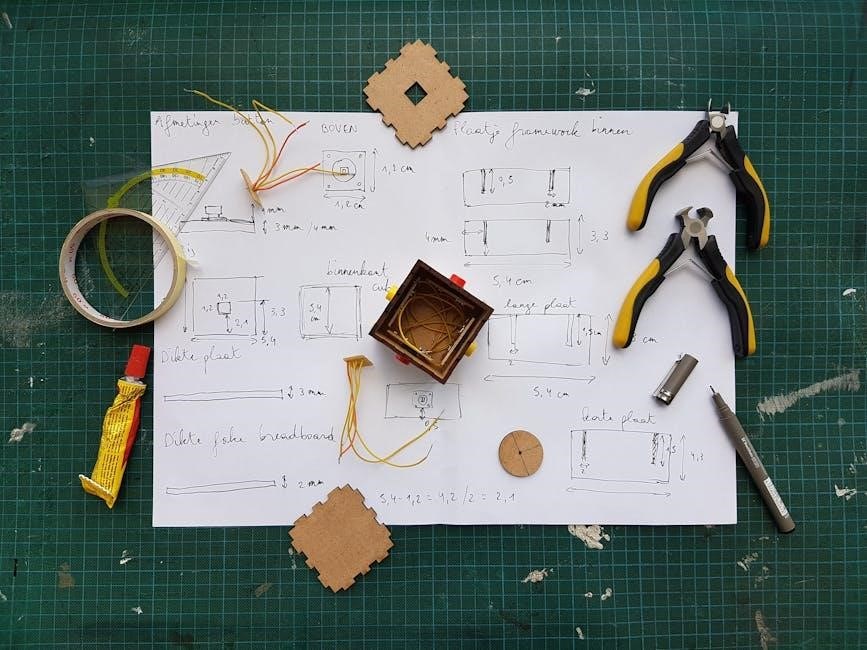Overview of Snap Circuits Jr
Snap Circuits Jr is an engaging educational kit designed for kids to explore basic electronics through hands-on learning․ With over 60 components, it allows children to build over 100 exciting projects, from simple circuits to complex designs, using color-coded, snap-together parts․ The included full-color manual guides beginners through step-by-step instructions, making it an ideal introduction to electricity and electronics;
Snap Circuits Jr is an educational kit designed for kids to learn basic electronics through hands-on experimentation․ It includes 30 color-coded, snap-together components like switches, lamps, and wires, allowing children to build over 100 exciting projects without soldering or tools․ The kit introduces fundamental concepts of electricity and circuits in a fun and intuitive way․ With a full-color manual guiding step-by-step, it’s perfect for beginners, fostering creativity and problem-solving skills while making learning electronics accessible and enjoyable for young minds․
Benefits of Using Snap Circuits Jr
Snap Circuits Jr offers numerous benefits for young learners, promoting hands-on experimentation with electronics․ It fosters problem-solving skills, creativity, and critical thinking while introducing basic electricity concepts․ The color-coded, snap-together design makes it easy for kids to build circuits without soldering, reducing frustration and enhancing learning․ The kit encourages STEM education, helping children develop an understanding of how electrical systems work․ By completing projects, kids build confidence and curiosity, laying the foundation for future interest in science and technology․ Its simplicity and safety make it an excellent tool for sparking creativity and innovation in young minds․

Understanding the Components
Snap Circuits Jr includes 30+ color-coded, snap-together parts like switches, lamps, wires, and motors․ Each component serves a specific function, making circuit-building intuitive and safe for kids․
Overview of Snap Circuits Parts
The Snap Circuits Jr kit contains over 30 distinct components, each designed with safety and simplicity in mind․ These include power sources like battery holders, switches, lamps, motors, and various lengths of wire․ The parts are color-coded to help users easily identify their functions, ensuring a straightforward building process․ The base grid provides a platform for assembling circuits, while snap connectors make it easy to link components without soldering․ This modular design allows kids to experiment with different configurations, fostering creativity and understanding of basic electronics principles․ The kit also includes specialized modules like sound and light effects, enhancing the learning experience․ By using these parts, children can create functional circuits and explore the fundamentals of electricity in a safe and engaging way․ The variety of components ensures that projects can range from simple to complex, accommodating different skill levels and interests․ With these tools, young learners can build confidence in their ability to design and construct electronic circuits, laying a solid foundation for future STEM exploration․ The clear labeling and intuitive design of each part make Snap Circuits Jr an excellent choice for introducing children to the world of electronics․
Functionality of Each Component
Each Snap Circuits Jr component serves a specific purpose, enabling kids to build functional electrical circuits․ The battery holder powers the system, while switches control the flow of electricity․ Lamps illuminate when connected correctly, and motors create movement․ Resistors regulate current, capacitors store electrical charge, and LEDs emit colorful light․ Specialized modules like sound ICs and voice recorders add audio effects, enhancing project diversity․ These components snap together effortlessly, allowing children to experiment with circuit design and understand how electricity flows through different configurations․ The functionality of each part is essential for creating interactive and educational projects, making complex electronics accessible to young learners․ This hands-on approach fosters creativity and problem-solving skills while teaching fundamental electronics concepts․ By interacting with these components, kids gain practical experience in designing and building circuits, preparing them for more advanced STEM challenges․ The clear functionality of each part ensures that every project is both fun and educational, encouraging a deeper understanding of electronics․
Color-Coding and Identification
Snap Circuits Jr components are color-coded for easy identification and organization․ Each part is assigned a specific color based on its function, such as red for power sources and green for ground connections․ This system helps users quickly recognize and locate components, simplifying the building process․ The base grid also uses color-coding to guide placement, ensuring proper connections․ The instruction manual includes a detailed guide to these colors, making it easier for beginners to understand and assemble projects․ This intuitive design enhances the learning experience, allowing kids to focus on creating functional circuits․ The color-coding system is a key feature that makes Snap Circuits Jr user-friendly and accessible for young learners․ By using consistent colors, the kit reduces confusion and encourages creativity in circuit design․ This visual approach helps children develop problem-solving skills while exploring electronics․ The color-coded components and grid work together to provide a clear and enjoyable learning environment․

Safety Guidelines
Ensuring safe usage is crucial when working with Snap Circuits Jr․ Always use the recommended batteries and avoid short circuits to prevent damage․ Adult supervision is advised for young children to guide them in following proper safety protocols․ Handle components with care to avoid breakage and injury․ Keep loose parts away from small children to prevent choking hazards․ Never force parts together, as this can cause damage or electrical issues․ By following these guidelines, users can enjoy a safe and educational experience with Snap Circuits Jr․
DOs and DON’Ts of Building Circuits
When building circuits with Snap Circuits Jr, always follow the instructions in the manual to ensure safety and functionality․ DO use the projects as guides and experiment safely after mastering the basics․ DO handle components gently to avoid damage and ensure proper connections․ DON’T attempt to modify or tamper with parts, as this can cause malfunctions or hazards․ DON’T ignore short circuits, as they can damage components․ Always keep loose parts away from small children to prevent choking hazards․ By adhering to these guidelines, users can enjoy a safe and educational experience while building creative circuits․
Basic Safety Precautions
Adult supervision is recommended when children are using Snap Circuits Jr․ Ensure batteries are inserted correctly and avoid mixing old and new batteries․ Never modify or tamper with components, as this can cause damage or safety risks․ Keep loose parts away from small children to prevent choking hazards․ Avoid short circuits, as they can damage parts or cause overheating․ Handle all components gently to maintain proper function․ Always follow the manual’s instructions and warnings to ensure a safe and enjoyable learning experience with Snap Circuits Jr․

Manual Overview
The Snap Circuits Jr instruction manual is divided into printed and online sections, offering step-by-step guides for 101 projects․ It includes color illustrations and clear instructions to help users build circuits effectively․ The printed manual covers projects 1-71, while the online manual extends to projects 72-101, providing a comprehensive learning experience for kids and beginners․ The manual also includes safety tips, component identification, and troubleshooting advice to ensure a smooth and enjoyable learning process․
Structure of the Instruction Manual
The Snap Circuits Jr instruction manual is organized into clear sections to guide users through building circuits․ It starts with a table of contents, followed by a parts list and safety guidelines․ The manual is divided into printed and online sections, with projects 1-71 detailed in the printed version and projects 72-101 available online․ Each project includes a description, required parts, and step-by-step assembly instructions․ The manual also features troubleshooting tips, advanced techniques, and an introduction to basic electricity concepts․ This structured approach ensures users can progress from simple to complex circuits seamlessly․
Printed Manual: Projects 1-71
The printed manual for Snap Circuits Jr includes detailed instructions for the first 71 projects, designed to introduce fundamental electronics concepts․ Each project is illustrated with clear diagrams and step-by-step instructions, guiding users through assembling circuits using the included components․ Projects range from simple configurations, like lighting an LED, to more complex setups involving motors and switches․ The manual’s visual approach ensures that even young learners can follow along easily, making it an excellent starting point for understanding circuit design and functionality․
Online Manual: Projects 72-101
The online manual for Snap Circuits Jr expands learning with Projects 72-101, offering advanced circuit designs and complex configurations․ These projects introduce users to higher-level electronics concepts, such as multi-component integration and troubleshooting techniques․ Detailed instructions and diagrams guide learners through building intricate setups, including alarms, voice recorders, and interactive toys․ Additional online resources, such as PDF downloads and interactive guides, enhance the learning experience; This digital extension encourages users to explore beyond the basics, fostering creativity and deeper understanding of circuitry and electronics․

Building Your First Circuit
Start with basic components like the battery holder, switch, and snap wires․ Follow the manual’s step-by-step guide to connect parts safely and understand circuit flow․
Step-by-Step Guide for Beginners
Begin by gathering essential components like the battery holder, switch, and snap wires․ Insert batteries into the holder, ensuring correct polarity․ Follow the manual’s numbered sequence to connect parts securely using snaps․ Start with simple circuits, such as Project 1, to light an LED․ Use the base grid to organize components and avoid overcrowding․ Always turn off the switch before adding or removing parts․ As confidence grows, experiment with combining elements like motors and lamps․ Remember to follow safety guidelines and avoid short circuits․ This hands-on approach makes learning electronics fun and accessible for young learners․
Understanding Series and Parallel Circuits
In Snap Circuits Jr, series circuits connect components end-to-end, allowing electricity to flow through one path․ Parallel circuits, however, split the current across multiple paths, enabling independent operation of components․ Series circuits require more voltage to power multiple components, while parallel circuits maintain consistent voltage across each branch․ Projects like “Electric Light” and “Motor Controlled Sounds” demonstrate these concepts․ Understanding these circuit types is crucial for building more complex designs and troubleshooting effectively․ The kit’s color-coded parts and manual guide users in identifying and assembling both types of circuits, fostering a deeper grasp of electrical connections and current flow․

Troubleshooting Tips
Common issues include short circuits, incorrect component connections, and faulty parts․ Check connections, ensure proper polarity, and test components individually․ Refer to the manual for guidance․
Common Issues and Solutions
Common issues with Snap Circuits Jr include short circuits, non-working components, and incorrect connections․ Short circuits occur when parts are connected without a load, causing excessive current flow․ To fix, ensure a proper load like a lamp or motor is included․ If components fail, check for damage or improper orientation․ Refer to the manual for correct polarity and connections․ Testing components individually can help identify faulty parts․ For persistent issues, consult the troubleshooting guide or contact customer support․ Always follow safety guidelines to prevent damage and ensure optimal performance․
Advanced Troubleshooting Techniques
For advanced troubleshooting, start by methodically testing individual components like ICs, LEDs, and resistors․ Use the troubleshooting guide in the manual to isolate issues․ If a component fails, build a simple circuit to test its functionality․ For ICs, try projects specific to their functions, such as alarms or sound effects․ Check connections and ensure proper polarity․ If issues persist, verify the circuit layout matches the manual’s instructions․ Use visual indicators like LED lights to trace current flow․ If components are damaged, replace them using spare parts or order replacements online․ Always refer to the manual for detailed repair steps․

Advanced Projects
Exploring Complex Circuit Designs
Snap Circuits Jr advanced projects challenge users to create intricate circuits, integrating multiple components like motors, LEDs, and ICs for unique outcomes, fostering problem-solving and creativity․
Advanced projects in Snap Circuits Jr encourage users to explore intricate circuit designs, combining multiple components like motors, LEDs, and ICs to create sophisticated systems․ These projects introduce concepts like series and parallel configurations, allowing for more dynamic and interactive creations․ With components such as sound modules and color LEDs, users can design circuits that produce music, lighting effects, and even simple games․ The full-color manual provides detailed guidance for these complex builds, ensuring an enriching experience that enhances both technical skills and creativity․ This level of complexity prepares users for more advanced electronics projects in the future․
Integrating Multiple Components
Integrating multiple components in Snap Circuits Jr allows users to create functional and interactive circuits․ By combining parts like switches, resistors, and electronic modules, children can design systems that perform specific tasks, such as activating lights or generating sounds․ The kit’s modular design simplifies the process of connecting components, enabling the creation of complex projects without soldering․ This integration fosters a deeper understanding of how different electronic elements work together, enhancing problem-solving skills and encouraging innovative thinking․ The step-by-step manual provides guidance for combining components effectively, ensuring a smooth learning curve for young engineers․

Creative Experimentation
Snap Circuits Jr encourages kids to design their own projects, fostering creativity and innovation․ With color-coded parts, children can experiment freely, learning through hands-on exploration and imagination․
Designing Your Own Projects
Designing your own projects with Snap Circuits Jr is an exciting way to apply creativity and problem-solving skills․ Encourage children to brainstorm ideas, sketch circuit layouts, and experiment with different components․ The color-coded parts make it easy to identify and connect pieces, while the manual provides a foundation for understanding circuit basics․ By building unique creations, kids gain confidence in their ability to innovate and troubleshoot, fostering a deeper interest in STEM fields․ This hands-on approach turns imagination into functional designs, making learning fun and rewarding․
Encouraging Innovation
Snap Circuits Jr fosters creativity by allowing kids to experiment beyond the manual’s projects․ Encourage them to invent unique devices, combining components in innovative ways․ This freedom to explore helps develop problem-solving skills and confidence․ By challenging children to think outside the box, Snap Circuits Jr turns learning into a fun, dynamic process․ It inspires young minds to envision and create, transforming abstract ideas into functional circuits․ This approach not only enhances STEM understanding but also nurtures a lifelong passion for innovation and hands-on discovery․

Educational Value
Snap Circuits Jr introduces kids to basic electricity and electronics through hands-on learning․ It teaches fundamental concepts like circuits, current, and voltage, promoting STEM understanding and problem-solving skills․
Learning Basic Electricity
The Snap Circuits Jr kit introduces kids to fundamental concepts of electricity, such as voltage, current, and circuits․ By building projects, children learn how electrical components like batteries, wires, and switches work together․ The color-coded parts make it easy to understand circuit flow and connectivity․ Projects progress from simple circuits with lamps and motors to more complex designs, teaching series and parallel connections․ This hands-on approach fosters a deep understanding of electricity, preparing young learners for advanced STEM topics while making learning fun and engaging through experimentation and creativity․
Understanding Electronic Modules
Snap Circuits Jr introduces kids to essential electronic modules, such as LEDs, resistors, and integrated circuits (ICs)․ These modules are pre-assembled and color-coded, making it easy for children to understand their functions․ LEDs emit light when powered, resistors control current flow, and ICs generate sounds or control sequences․ By incorporating these modules into circuits, kids learn how electrical signals are processed and amplified․ This hands-on experience helps develop an understanding of voltage, current, and signal processing, laying the groundwork for more complex electronics concepts and inspiring a deeper interest in STEM fields through interactive learning․
Snap Circuits Jr is a valuable tool for fostering creativity and learning in young minds․ It simplifies complex electronics concepts, making them accessible and fun for kids, while encouraging STEM exploration and innovation through hands-on activities․ Perfect for beginners, it sparks an interest in technology and engineering, providing a solid foundation for future discoveries․ Continue exploring and experimenting with the endless possibilities Snap Circuits Jr offers, using the provided manuals and guides to unlock even more creative potential․
Final Thoughts on Snap Circuits Jr
Snap Circuits Jr is an exceptional learning tool that simplifies complex electronics into fun, hands-on activities․ With its color-coded components and clear instruction manual, it makes electricity and circuit-building accessible to children․ The kit fosters creativity, critical thinking, and problem-solving skills while introducing fundamental STEM concepts․ Its safety features and step-by-step guidance ensure a smooth learning experience․ Whether building simple circuits or exploring advanced projects, Snap Circuits Jr provides endless opportunities for growth and innovation․ It’s a perfect gift for curious young minds, encouraging a lifelong passion for science and technology․
Encouraging Continued Exploration
Snap Circuits Jr inspires kids to explore beyond the manual, fostering a love for STEM through creative experimentation․ By mastering basic circuits, children gain confidence to design their own projects, integrating multiple components and discovering how electricity powers everyday devices․ The kit’s flexibility and comprehensive resources, including online guides, motivate learners to delve deeper into electronics․ Encouraging curiosity and innovation, Snap Circuits Jr equips young minds with essential skills, preparing them for future challenges in science and technology while making learning an enjoyable adventure․

Additional Resources
Access comprehensive guides and manuals online, offering detailed instructions for projects 1-134․ Download free PDF manuals, student guides, and explore troubleshooting tips to enhance learning experiences with Snap Circuits Jr․
Downloading Manuals
Downloading manuals for Snap Circuits Jr is straightforward․ Visit the official Elenco website or trusted platforms like ManualsLib to access free PDF versions․ The manuals are divided into printed and online sections, covering projects 1-71 and 72-134 respectively․ Ensure compatibility by selecting the correct model, such as SC100 or SC130․ These guides feature detailed instructions, color illustrations, and troubleshooting tips, making them invaluable for both beginners and advanced users․ Print or save digitally for easy reference while building circuits; Regularly check for updates to access new projects and features․
Accessing Online Guides
Accessing online guides for Snap Circuits Jr is convenient and enhances your learning experience․ Visit the official Elenco website or platforms like ManualsLib to find comprehensive digital resources․ These guides include detailed instructions, diagrams, and troubleshooting tips․ Projects 72-134 are exclusively available online, offering advanced challenges․ Additionally, you can view or download PDF versions of manuals, student guides, and teacher resources․ Online guides often include updates, new project ideas, and interactive features to help you master circuit building․ Explore these resources to expand your creativity and technical skills with Snap Circuits Jr․

